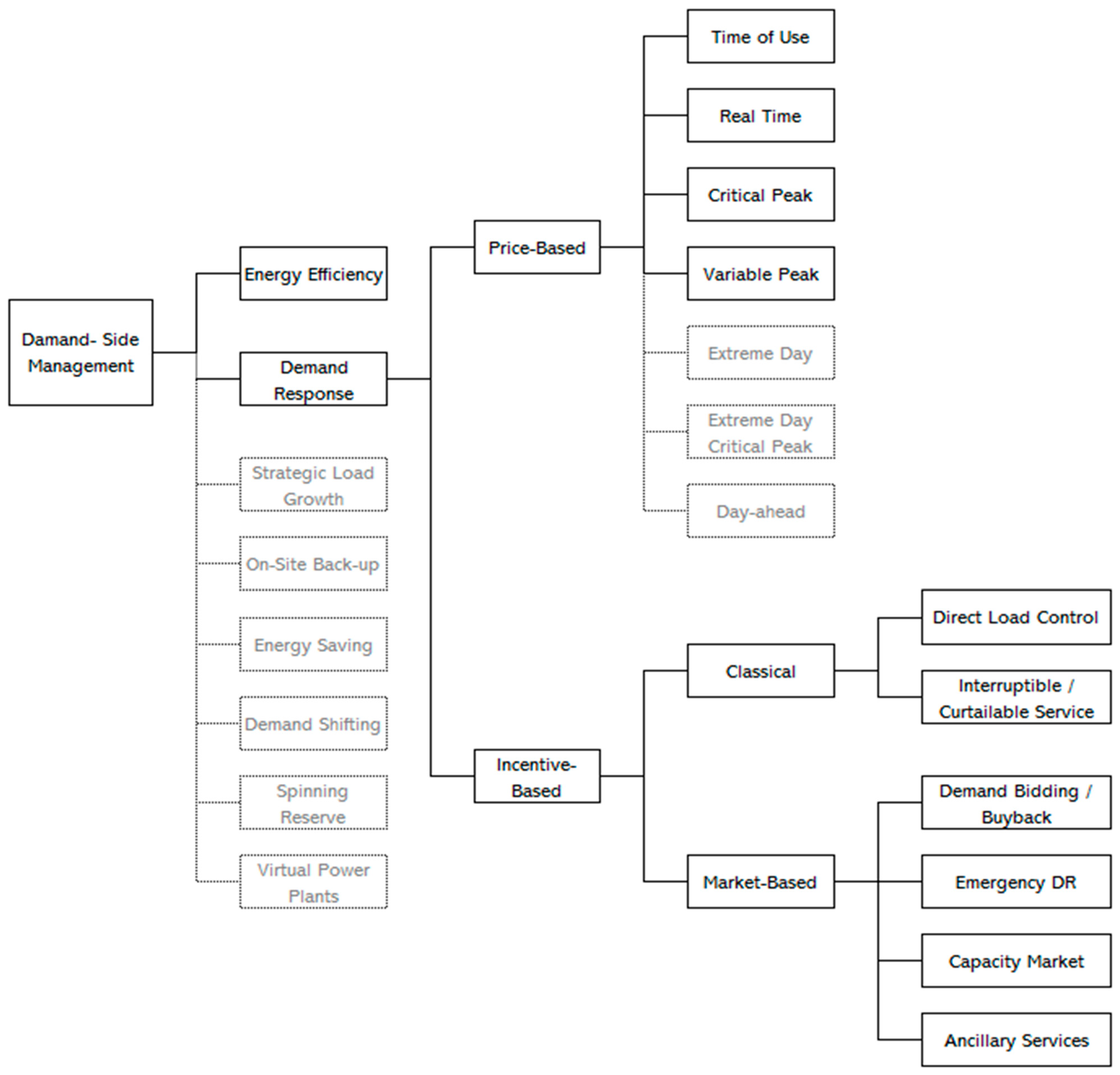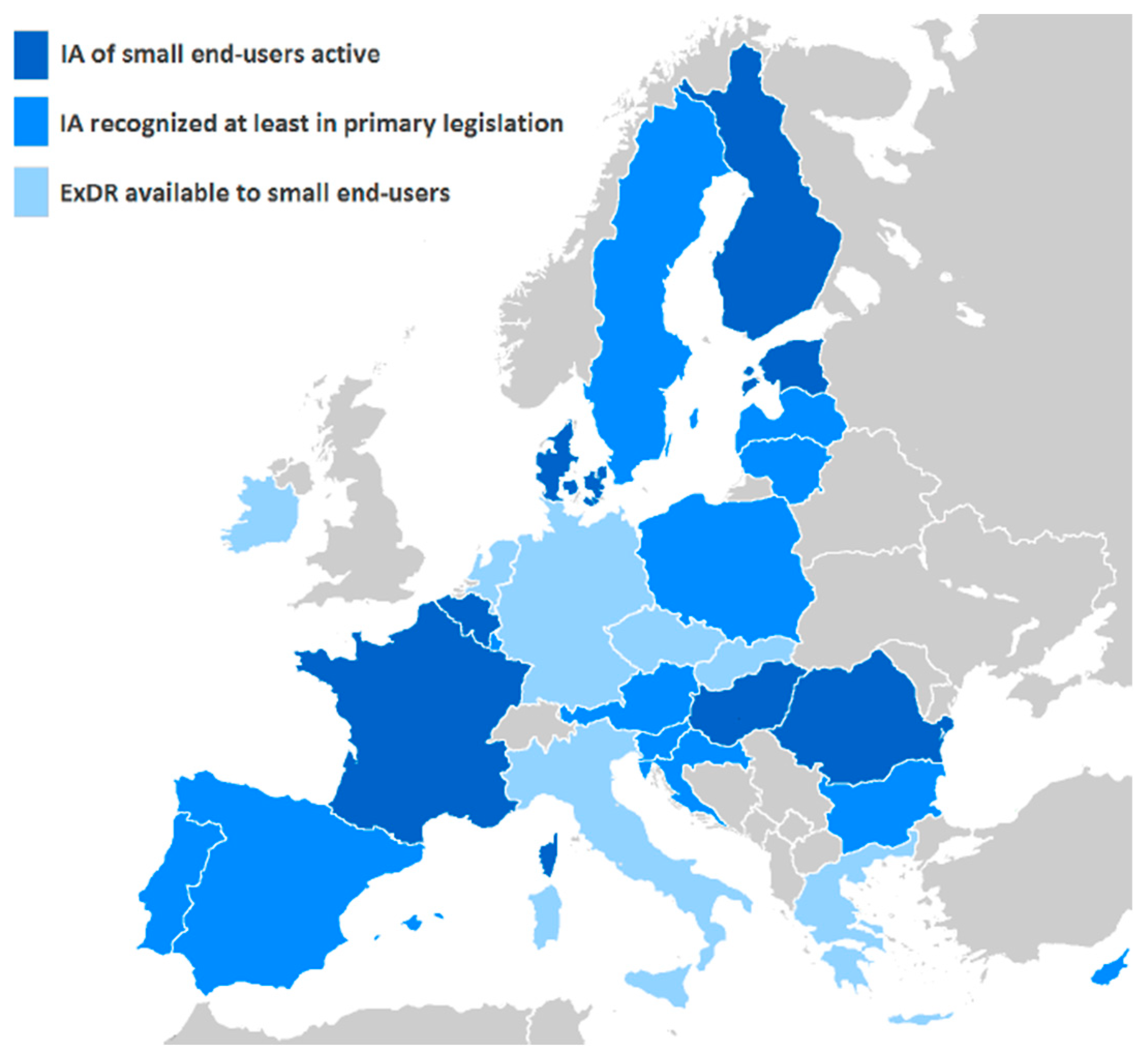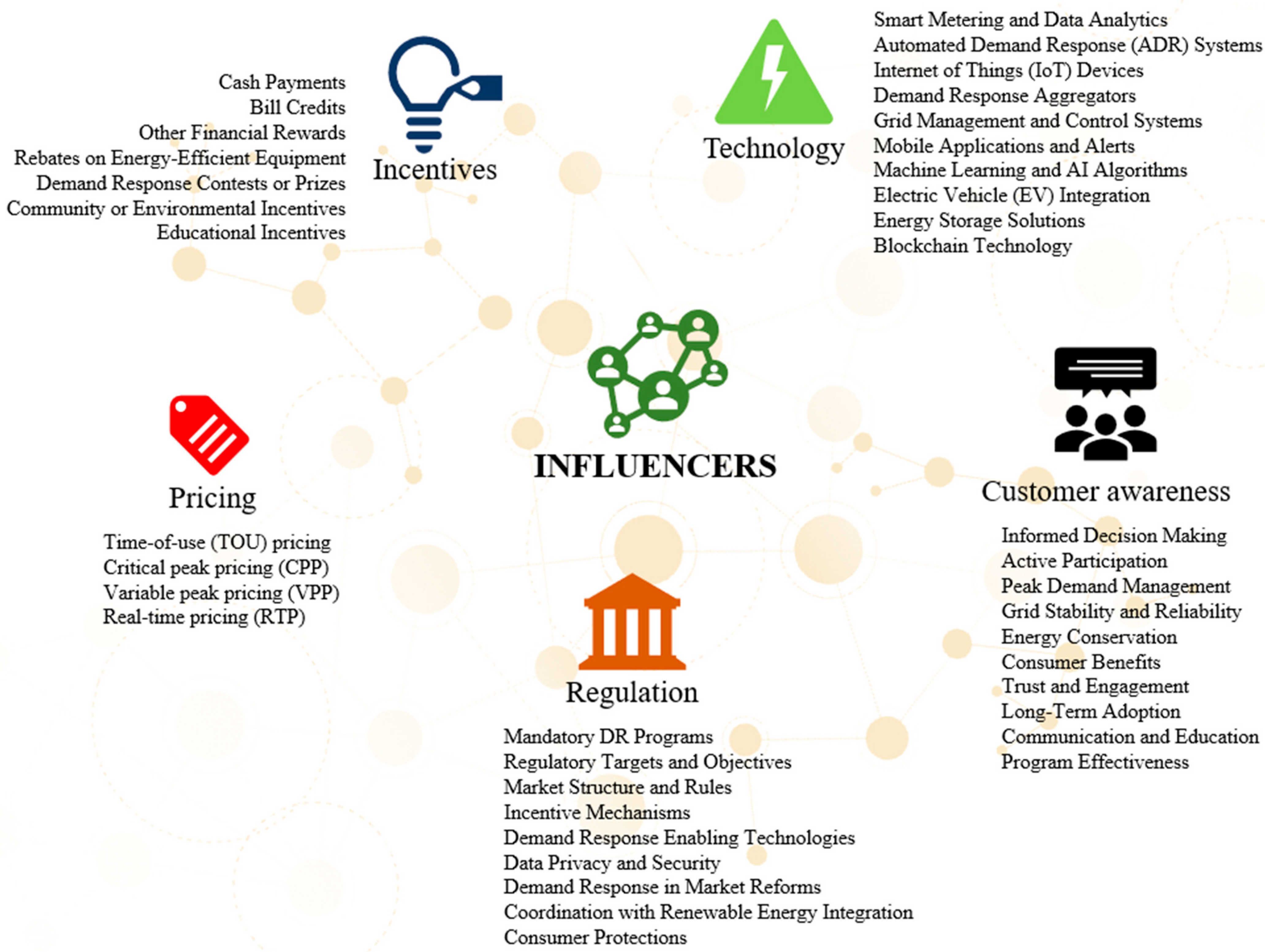
| Version | Summary | Created by | Modification | Content Size | Created at | Operation |
|---|---|---|---|---|---|---|
| 1 | Karina Viskuba | -- | 2865 | 2023-10-18 22:19:09 | | | |
| 2 | Peter Tang | Meta information modification | 2865 | 2023-10-19 04:37:51 | | |
Video Upload Options
The role of demand response increases considerably with a higher share of renewable energy sources in the energy mix, characterized with more frequent energy market price fluctuations due to mismatch between uncontrollable weather-dependent production and currently relatively inflexible energy consumption. Reallocation of energy consumption from high-price hours to lower price hours helps to avoid extra costs to the entire economy and ensures the possibility to minimize fossil-based energy generation, therefore contributing to the achievement of zero-emission goals.
1. Introduction
2. The Nature of Demand-Side Management and Demand Response
2.1. The Evolution of Demand-Side Management

2.2. Demand Response Products and Services
-
An implicit or price-based scheme in which the same time is self-dispatched or a load is controlled indirectly. Electricity consumers change or reallocate their consumption reflecting electricity price or cost signals. Electricity suppliers offer different pricing products that depend on time, for example, day and night prices or dynamic pricing based on wholesale market prices. As this is an indirect load control scheme, there is no two-way communication between consumers and operators, except a response of aggregated consumers, which can be measured by operators. Consumers make decisions individually, and in order to make them more efficient, smart metering and home energy management systems are required. The main purpose of these programs is to smooth the demand curve by offering a high price during peak periods and lower prices during off-peak periods [18][21][22][33][34][35][36].
-
An explicit or incentive-based scheme, in which dispatchment is conducted by a third party classified as any of the following: transmission system operators, distribution system operators, or the utility or retailer of the energy user and a DR aggregator. An explicit DR scheme consists of direct load control and market-based mechanisms, which allow the trading of the participant’s dispatchable flexibility in energy markets. This DR case is based on two-way communication and agreements, which lowers the risk of response unpredictability but may affect the consumer’s independent decision and comfort level. Usually the incentive-based schemes are implemented by an aggregator [21][22][33][34][35][36].


3. The Influencers of Demand Response Implementation and Performance

-
Incentives can be used to encourage consumers to participate in DR programs. These incentives can include cash payments, bill credits, or other rewards [32].
-
The availability of technology can also influence DR implementation and performance. For example, smart meters can be used to track and manage energy consumption, which can make it easier for consumers to participate in DR programs [40].
-
Customer awareness of DR programs is also important. If consumers are not aware of the benefits of DR, they are less likely to participate in those programs [42].
|
Influencers |
Enables |
Barriers |
|
|---|---|---|---|
|
Pricing |
TOU |
Understandable and straightforward implementation |
Less effective in sharp peak curtailments |
|
CPP |
Effectively empowers grid stability Additional revenue for utilities during peak periods |
Poor management can result in lower participation level |
|
|
VPP |
Moderate stimulus for load shifting |
Quite dynamic pricing signals |
|
|
RTP |
Electricity consumption optimization based on real-time market |
Advanced information and communication infrastructure |
|
|
Incentives |
Financial rewards or other benefits for consumers |
Financial resources for incentives from utilities and grid operators |
|
|
Higher customer loyalty |
Overcompensation risk |
||
|
Promote environmentally friendly energy system and eco-friendly technologies |
Budget constraints of utilities may limit incentives and lead to lower participation rates |
||
|
Cost savings for utilities and grid operators |
Complex and time-consuming administration |
||
|
Technical requirements |
|||
|
Technology |
Real-time monitoring and control |
Upfront costs for utilities and consumers |
|
|
Informed decision making |
Privacy and security concerns |
||
|
Faster, more precise responses |
Digital divide between consumers |
||
|
Optimized DR strategies |
Complexity that requires technical expertise and trainings |
||
|
Automated DR |
Malfunctioning issues or lack of compatibility |
||
|
Emergence of DR aggregators |
|||
|
Customer awareness |
Familiarity and knowledge |
Unfamiliarity and lack of knowledge |
|
|
Social motivations |
Distrust |
||
|
Innovativeness |
Technology requirements and technical issues |
||
|
Financial and other benefits |
Financial costs |
||
|
Environmental motivations |
Risks—finance, autonomy, comfort, adaptability |
||
|
Reputation |
|||
|
Regulation |
Financial incentives |
Additional compliance (administrative, financial) costs for utilities and other stakeholders |
|
|
Regulatory support |
Complex and challenging compliance process |
||
|
Promotion of technology adoption |
Slow and changeable regulation |
||
|
Standardization |
Government-mandated DR programs may lack flexibility |
||
|
Regulations and clear guidelines on data privacy and security |
|||
|
Empowerment of market competition |
|||
|
Transparent and fair regulations build trust and enhance participation rates |
|||
References
- Canizes, B.; Silveira, V.; Zita, V. Demand response and dispatchable generation as ancillary services to support the low voltage distribution network operation. Energy Rep. 2022, 8, 7–15.
- Bogdanova, O.; Pigeons, K. Factors affecting energy costs: Green deal impact. In Towards Climate Neutrality: Economic Impacts, Opportunities and Risks, 1st ed.; Šteinbuka, I., Bogdanova, O., Eds.; University of Latvia Press: Riga, Latvia, 2023; pp. 70–86.
- National Renewable Energy Laboratory. Potential Roles for Demand Response in High-Growth Electric Systems with Increasing Shares of Renewable Generation. Available online: https://www.nrel.gov/docs/fy19osti/70630.pdf (accessed on 24 July 2023).
- Stanelyte, D.; Radziukyniene, N.; Radziukynas, V. Overview of demand-response services: A review. Energies 2022, 15, 1659.
- Gellings, C.W. The concept of demand-side management for electric utilities. Proc. IEEE 1985, 73, 1468–1470.
- Gellings, C.W.; Chamberlin, J.H. Introduction. In Demand-Side Management: Concepts and Methods, 1st ed.; The Fairmont Press, Inc.: Atlanta, GA, USA, 1988; pp. 1–11.
- Gellings, C.W. Evolving practice of demand-side management. J. Mod. Power Syst. Clean Energy 2017, 5, 1–9.
- Gellings, C.W. The smart grid—Enabling demand response—The dynamic energy systems concept. In The Smart Grid: Enabling Energy Efficiency and Demand Response; River Publishers: Aalborg, Denmark, 2020; pp. 131–151.
- Gellings, C.W.; Chamberlin, J.H. Introduction. In Demand-Side Management: Concepts and Methods, 2nd ed.; The Fairmont Press, Inc.: Atlanta, GA, USA, 1993; pp. 2–3.
- Beesley, M.; Littlechild, S. The regulation of privatized monopolies in the United Kingdom. Rand J. Econ. 1989, 20, 454–472.
- Joskow, P.L. Regulatory failure, regulatory reform, and structural change in the electrical power industry. Brook. Pap. Econ. Act. 1989, 20, 125–208.
- Joskow, P.L. Introducing competition into regulated network industries: From hierarchies to markets in electricity. Ind. Corp. Change 1996, 5, 341–382.
- Joskow, P.L. Lessons learned from electricity market liberalization. Energy J. 2008, 29, 9–42.
- Synapse Energy Economics Inc. Demand Response as a Power System Resource. Available online: https://www.synapse-energy.com/sites/default/files/SynapseReport.2013-03.RAP_.US-Demand-Response.12-080.pdf (accessed on 15 July 2023).
- U.S. Energy Information Administration. US Electric Utility Demand-Side Management. 2000. Available online: https://www.eia.gov/electricity/data/eia861/dsm/ (accessed on 15 July 2023).
- Greening, L.A. Demand response resources: Who is responsible for implementation in a deregulated market? Energy 2010, 35, 1518–1525.
- Eissa, M.M. Demand side management program evaluation based on industrial and commercial field data. Energy Policy 2011, 39, 5961–5969.
- Warren, P. A Review of demand-side management policy in the UK. Renew. Sustain. Energy Rev. 2014, 29, 941–951.
- Warren, P. Demand-Side Management Policy: Mechanisms for Success and Failure. Ph.D. Thesis, UCL Energy Institute, University College London, London, UK, August 2015.
- U.S. Energy Information Administration. National Action Plan for Energy Efficiency. Coordination of Energy Efficiency and Demand Response. Available online: https://www.epa.gov/sites/default/files/2015-08/documents/ee_and_dr.pdf (accessed on 16 July 2023).
- Morales-Espana, G.; Martínez-Gordon, R.; Sijm, J. Classifying and modelling demand response in power systems. Energy 2022, 242, 122544.
- Kinhekar, N.; Padhy, N.P.; Gupta, H.O. Multiobjective demand side management solutions for utilities with peak demand deficit. J. Int. Electr. Power Energy Syst. 2014, 55, 612–619.
- Lampropoulos, I.; Kling, W.L.; Ribeiro, P.F.; Berg, J. History of demand side management and classification of demand response control schemes. In Proceedings of the IEEE Power and Energy Society (PES) General Meeting, Vancouver, BC, Canada, 21–25 July 2013.
- Akbari-Dibavar, A.; Farahmand-Zahe, A.; Mohammadi-Ivatloo, B. Concept and glossary of demand response programs. In Demand Response Application in Smart Grids: Concepts and Planning, 1st ed.; Nojavan, S., Zare, K., Eds.; Springer: Berlin/Heidelberg, Germany, 2020; Volume 1, pp. 1–15.
- Bakr, S. Dynamic Demand Response in Residential Prosumer Collectives. Ph.D. Thesis, University of Otago, Dunedin, New Zealand, 30 June 2018.
- U.S. Department of Energy, Office of Scientific and Technical Information. Energy Efficiency and Electric System Reliability: A Look at Reliability-Focused Energy Efficiency Programs Used to Help Address the Electricity Crisis of 2001. Available online: https://www.osti.gov/servlets/purl/812819 (accessed on 16 July 2023).
- Behrangrad, M. A review of demand side management business models in the electricity market. Renew. Sustain. Energy Rev. 2015, 47, 270–283.
- Tronchin, L.; Manfren, M.; Nastasi, B. Energy efficiency, demand side management and energy storage technologies—A critical analysis of possible paths of integration in the built environment. Renew. Sustain. Energy Rev. 2018, 95, 341–353.
- World Energy Council. The World in 2050: Explore MAP Phase Insights. Visionario Project Map Phase Analysis. Available online: https://www.worldenergy.org/assets/downloads/FEL_Visionario_MAP_Phase_Analysis_Presentation.pdf?v=1662554370 (accessed on 10 August 2023).
- FERC. Assessment of Demand Response and Advanced Metering. Available online: https://www.smartgrid.gov/files/documents/2010-dr-report.pdf (accessed on 17 July 2023).
- Albadi, M.H.; El-Saadany, E.F. Demand response in electricity markets: An overview. In Proceedings of the IEEE Power Engineering Society General Meeting, Tampa, FL, USA, 24–28 June 2007; pp. 1–5.
- International Energy Agency. Demand Response. Available online: https://www.iea.org/energy-system/energy-efficiency-and-demand/demand-response#programmes (accessed on 17 July 2023).
- Usman, R.; Mirzania, P.; Alnaser, S.W.; Hart, P.; Long, C. Systematic review of demand-side management strategies in power systems of developed and developing countries. Energies 2022, 15, 7858.
- De Zotti, G. Leveraging Consumers’ Flexibility for the Provision of Ancillary Services. Ph.D. Thesis, Technical University of Denmark, Kongens Lyngby, Denmark, 2019.
- TNO. The Role of Demand Response in the Power System of The Netherlands, 2030–2050. Available online: https://publications.tno.nl/publication/34639481/emVYyq/TNO-2022-P10131.pdf (accessed on 21 July 2023).
- Assad, U.; Hassan, M.A.S.; Farooq, U.; Kabir, A.; Khan, M.Z.; Bukhari, S.S.H.; Jaffri, Z.u.A.; Oláh, J.; Popp, J. Smart Grid, Demand Response and Optimization: A Critical Review of Computational Methods. Energies 2022, 15, 2003.
- Saviuc, I.; Lopez, C.; Puskas, A.; Rollert, K.; Bertoldi, P. Explicit Demand Response for Small End-Users and Independent Aggregators, EUR 31190 EN; Publications Office of the European Union: Luxembourg, 2022; pp. 1–132.
- Wang, Z.; Sun, M.; Gao, C.; Wang, X.; Ampimah, B.C. A new interactive real-time pricing mechanism of demand response based on an evaluation model. Appl. Energy 2021, 295, 117052.
- Eid, C.; Koliou, E.; Valles, M.; Reneses, J.; Hakvoort, R. Time-based pricing and electricity demand response: Existing barriers and next steps. Util. Policy 2016, 40, 15–25.
- Jasevics, A.; Zemite, L.; Kunickis, M. Demand load control with smart meters. In Proceedings of the 2017 IEEE 58th Annual International Scientific Conference on Power and Electrical Engineering of Riga Technical University, Riga, Latvia, 10–12 October 2017.
- Sauhats, A.; Zemite, L.; Petrichenko, L.; Moshkin, I.; Jasevics, A. A estimating the economic impacts of net metering schemes for residential PV systems with profiling of power demand, generation, and market prices. Energies 2018, 11, 3222.
- Ferreira, P.; Rocha, A.; Araújo, M. Awareness and attitudes towards demand response programs—A pilot study. In Proceedings of the International Conference on Smart Energy Systems and Technologies (SEST), Seville, Spain, 10–12 September 2018.




